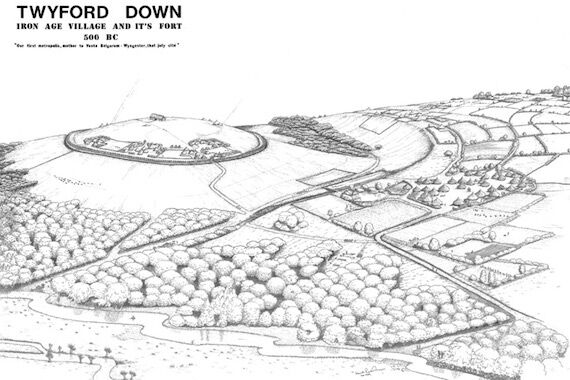However Roman occupation chose to settle on the West side of the River Itchen, leaving the original pre-historic village and its field systems abandoned but intact. As Roman Winchester grew a significant Roman decided to build a villa outside of the town and he chose a spot with excellent views, the remains of that villa along with its mosaic floors lies under the 9th green. The double ditch and banks just short of the 9th are all that remains of the fortification protecting the villa. You first come across these remains as undulations directly in front of the 7th green and if you follow them to the left you can see where they turn the corner in the rough just before the 11th fairway. Over the years numerous Roman artefacts have been found around the 9th green including Mosaic tiles, coins, shards of pottery, knives, nails and bricks along with both animal and human remains. Elsewhere on the course an Iron Age plough, Medieval, Roman and Iron Age brooches, Roman coins and Roman pottery have been found.
(The whole of the above area is one of two designated 'Scheduled Ancient Monument' areas that cover large parts of the Hockley estate - and the Club is proud to maintain it's duties under these responsibilities).
For many years it was believed that the ditch in front of the 15th green was part of a much later period caused by sheep drovers roads or tracks however there is another theory to be explored shortly that this ditch is in fact the remains of a Roman track which ran from the Roman Road as it emerges out of Winchester on its way to Portchester, to the Villa site under the 9th. It is certainly ancient but if it were a sheep track way the eroded soil would have spilt out across the valley just beyond the 4th tee. However it has become clear that the soil taken out from in front of the 15th was carefully placed as an earth causeway in front of the 4th tee, this cut and fill resulted in a more level route from Roman Winchester across to the villa. This ancient feature and many other residual earthworks on the golf course have yet to be fully explored.
About this time the design of the plough changed to being able to turn the more heavy and fertile soils resulting in improvements in crop production. This meant that the chalk soils, being so infertile, were abandoned for crop growing, giving way to sheep that were grazed in vast numbers across the Chalk Downs of Southern England. Wool became a major contributor to our economy and Winchester was an important centre for collection and export out through Ports, like the one at Botley, in Medieval times. Today we can still see evidence of sheep movement in the form of eroded sheep track ways crossing this part of the Downs on their way to Winchester. The remains of these track ways can first be seen as parallel undulations in front of the 6th green and then again in front of the 7th, the 12th and the 13th tees. In places they are up to 1 meter deep but beside the M3 they are massive, reaching 4-5 meters deep.









